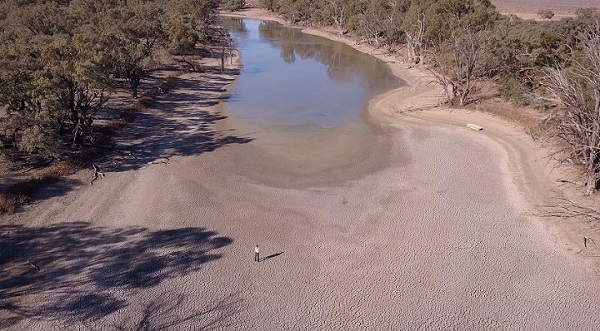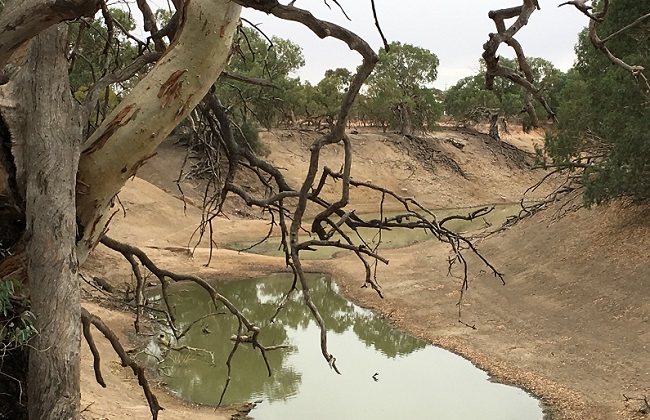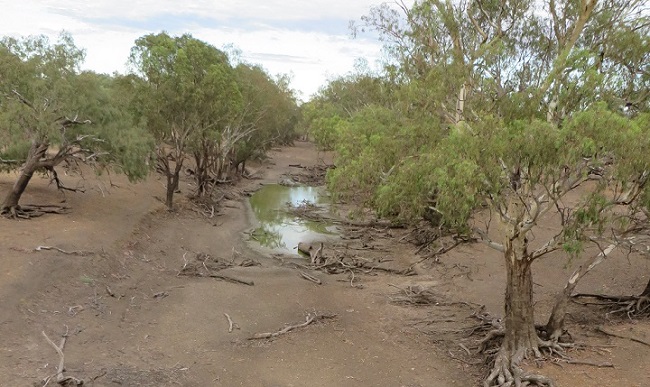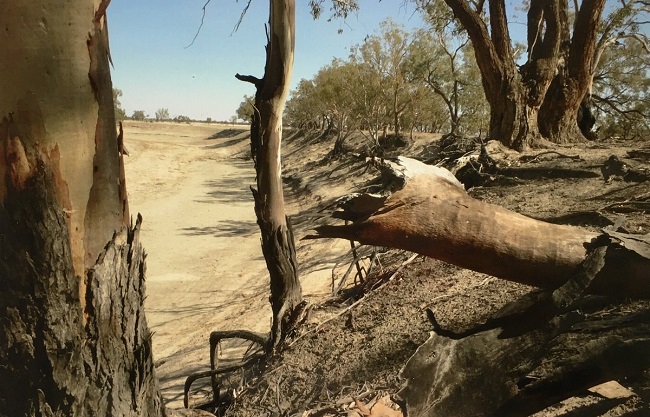Dr Emma Carmody, EDO Special Counsel and water law expert, gave this talk at the 10th Water Symposium, hosted by Legalwise in Sydney on 18 October 2019.
Introduction
My presentation is, broadly speaking, oriented towards the future, although anyone who has visited Menindee or Wilcannia in the last year might be inclined to argue that the future is already upon us; that the Darling or Barka, as it is known to its Traditional Owners, is rapidly becoming our very own Aral Sea, having experienced increasingly frequent and extended periods of low and no flows since Federation, and in particular over the last 20 years.[1]
I’ll return to the Darling – and the interface between over-extraction and climate change – in due course. Before I do – and because it’s impossible to design a ‘climate ready’ legal regime without first attempting to grapple with the grand meteorological narratives of our time – I’ll discuss some of the available data, with a particular emphasis on the Murray-Darling Basin (MDB).

Past, present and future
As examining climatic data is a little like conjugating a verb, I’ll touch on the recent past, present and finally future projections, which are of course based on complex modelling.
Australia is, yet again, in the midst of a devastating drought. In the words of the West Australian poet John Kinsella, pasture across the Basin is… ‘erupting like hot tongues/lashing out at the rainless storm/declaring green fields the camouflage of the ‘uncomprehending’…/’.[2]
General security licences in numerous river valleys including the Lower Darling, Lachlan, Belubula and Macquarie Cudgegong have received no allocations for over two years.
Records continue to be broken across the northern MDB in relation to rainfall, stream flows, storage levels and soil moisture, while temperatures in the years preceding the now infamous fish kills in the Menindee Lakes and Lower Darling were unusually high. This was, according to a report by the Australian Academy of Science, attributable to a step change in climate.[3]

I’ll enliven these trends by citing a few statistics:
- In the first instance, rainfall diminished across the Basin in the 24 months to March 2019, with the spatial extent of areas experiencing the lowest rainfall on record increasing over time.[4]
- When compared to other 33 month periods commencing in January, the 33 months from January 2017 to September 2019 has been the driest on record averaged over the MDB, as well as over the northern MDB and NSW as a whole.[5]
- Winter rainfall was well below average across most of eastern Australia, with record lows being recorded in significant parts of the MDB.
- Burrendong Dam, which feeds the Macquarie and Cudgegong catchments, is currently at 4.4 percent and falling, and continues to experience its worst ever drought inflow sequence on record.[6]
- Copeton Dam, which feeds the Gwydir catchment, is at 8.5 percent. The dam has received a mere 31 gigalitres of inflow over the last 20 months, which is the lowest on record.[7]
- Keepit and Split Rock Dams in the Namoi catchment are less than 1 percent and 2 percent full, respectively. The NSW Government has indicated that ‘actual inflow is now much less than the historical minimum inflow, while ‘actual transmission losses and evaporation are worse than those expected based on prior practice.’[8] The graph on the screen demonstrates the discrepancy between actual and budgeted inflows and losses.
- According to the Bureau of Meteorology (BOM), ‘groundwater resources have been significantly affected by the prolonged dry period.’ This is due to a combination of reduced rainfall and stream recharge, and increased extractions for consumptive uses due to surface water scarcity.[9]
- In the 24 months to April 2019, root zone soil moisture for the Namoi, Murrumbidgee, Castlereagh, Condamine-Culgoa, Macquarie-Bogan and Warrego catchments was the lowest on record. According to the BOM, ‘these values provide an estimate of the moisture stress experienced by vegetation and the severity of agricultural drought.’ [10]
The tenor of these recent changes is consistent with longer-term trends in the Basin and beyond. The BOM tells us, for example, that ‘the current drought has been taking place against the backdrop of consistently rising temperatures’ with the MDB experiencing some of the most rapid warming over the last few decades[11] (the corollary of which is increased evaporation). April to October rainfall in southeastern and southwestern Australia has also been trending downwards since the 1990s. According to the State of the Climate Report 2018, ‘the drying in recent decades across southern Australia is the most sustained large‐scale change in rainfall since national records began in 1900.’[12]
In other words, clear signals are emerging from the more general climatic noise which indicate that we are being confronted with an era-defining phenomenon, one that is on course to transform our relationship with our most precious resource.
This is reinforced by projections about the likely, future climate in NRM regions across Australia based on up to 40 global climate models. Projections for the Central Slopes and Murray Basin clusters (which cover the northern and southern MDB, respectively), indicate that there is a ‘very high level of confidence’ that the following will occur: more hot days and warm spells in all seasons; decreased average winter rainfall; more extreme rainfall events; and a harsher fire weather climate.[13] For those who are interested, detailed information regarding climate projections for the entire continent at different scales can be found on the Climate Change in Australia website, which is a joint initiative of the CSIRO and BOM.
These projections are a stark reminder – if ever we needed one – that the past is no longer a reliable predictor of the future; that managing our water resources on the basis of the historic climate record is a perilous pursuit, not least of all because it renders us ill-equipped to govern proactively and mitigate risk effectively. This in turn increases our vulnerability as a nation as weather systems change, possibly more rapidly than anticipated given the inherent non-linearity of global warming.

What does it mean to be climate ready?
I’ve spent a good 15 minutes conjugating climate data and discussing root zone soil moisture – not for your entertainment – but because it is a condition precedent to exploring what it might mean for our laws to be climate ready.
Some of you may query whether it is indeed possible to prepare for something as inherently uncertain and non-linear as global warming. As I would never presume to know more than a Nobel Prize winning physicist, I’ll attempt to quell your doubts by quoting Professor Stephen Chu:
‘While we cannot accurately predict the course of climate change in the coming decades, the risks we run if we don’t change our course are enormous. Prudent risk management does not equate uncertainty with inaction.’
Put simply, climate readiness is concomitant with risk anticipation and mitigation. This should in turn build ecological and socio-economic resilience; systems capable of adapting and functioning within the context of reduced water availability. This logically requires a firm resolve to live within our hydrological means; to reject what I call ‘hydrodenialism’.
This broad philosophical approach is gaining momentum globally. Despite the dam-building mania that takes hold of our political class every time we are in drought, the use of ‘grey solutions’ is finally being questioned by experts, many of whom favour an approach that reflects the hydrological and ecological reality of a particular environment, and works with, rather than against, nature and climate.
At a more granular level, this translates into a number of specific features, all of which would ideally be inscribed in law. These include:
- an evidence-based cap on extractions at catchment and basin scales which is informed by climate projections;
- an adaptive water allocation scheme with an embedded climate projection signal;
- protecting environmental flows from extraction;
- protecting different components of the flow regime (from no flows to overbank flows), each of which is required to maintain ecosystem function;[14]
- promotion of longitudinal and latitudinal connectivity. To clarify, this requires catchment-based legal instruments to speak to one another;
- in regulated river systems, managing public storages on the basis of climate projections, not historic climate data;
- accurately measuring and reporting water extractions (noting the difficulty of enforcing the law at the licence holder and catchment levels in the absence of reliable evidence);
- fulsome monitoring of groundwater resources, and appropriate limits on extractions which take into account connectivity with surface water, as well as the tendency to shift to consumption from aquifers during periods of water scarcity;
- accurate water accounting which, inter alia, takes into account return flows, water theft and floodplain harvesting;
- appropriate governance arrangements for subsidised irrigation modernisation projects, including a requirement to demonstrate that they are actually saving water;
- a requirement to ensure modelling for compliance purposes is based on latest levels of development and its assumptions are transparent and communicable.
- the inclusion of clear duties to, for example, act on the basis of best-available evidence and protect water resources from over-extraction;
- appropriately drafted civil and criminal offence provisions supported by an independent regulator, such as the NSW Natural Resources Access Regulator;
- third party standing (this is particularly important given the virtual impossibility of obtaining a writ of mandamus compelling the government to enforce its own laws); and
- more generally, provisions that are justiciable. While there is a clear need to furnish Ministers and their delegates with some discretion, broadly drafted powers can make it all but impossible for clients to seek judicial review of environmentally foolish decisions, which is deeply problematic. In short, hydrodenialism should give rise to the possibility of legal action.
So. We’ve succeeded in designing a climate-ready legal framework. However – and even if each of these features were faithfully transcribed into our statute books – there is no guarantee that they would be implemented by our governments. Globally, environmental laws tend to be poorly enforced,[15] and water law in Australia is certainly no exception. Indeed, where there is water, there is money and where there is money, there is power. And in a modern democracy, power finds its ultimate expression in the interplay between industry and politics.
If we are prepared to accept the inherent nexus between water, politics and power, and the very real possibility that even good laws will not be enforced, we need to do three things.
First, ensure that water laws include robust transparency and governance provisions that are designed to thwart political interference, maladministration and corruption.
Second, establish truly independent water agencies that are incentivised – and legally required – to rise above the political fray.
Third, consider the role that deliberative democracy could play in transforming the cultural context within which water management, law and decision-making takes place.
Briefly, deliberative democracy places conversation, diverse views, informed reflection and respectful listening at the heart of decision-making processes. Empirical research has shown that deliberative democracy reduces polarization, promotes considered judgement and counteracts populism.[16] Deliberative democratic processes have been used around the world to amend constitutions in otherwise fractious political settings and to shift perspectives in relation to ideologically-driven issues such as immigration and environmental management.

Are we climate ready?
Having discussed the science and established a schematic framework for a climate-ready legal system, I’d now like to consider whether water laws in the MDB are equipped to mitigate climate-related risk and by way of extension, build socio-economic and ecological resilience for future generations. Put differently, are we living within our current and projected hydrological means?
The short answer is, unfortunately, no. Despite waves of water reform, we remain in a state of politicized hydrodenialism, as reflected in the Water Supply Critical Needs Bill, which was tabled this week in the NSW Parliament. Others have described this as the ‘hydro-illogical cycle’.[17]
This Bill, and other schemes like it, are anchored in the folkloric notion that we can somehow ‘drought proof’ the driest inhabited continent on Earth with pipes and dams. To quote Professor John Williams, such a notion is ‘… fraught with risk because it invites us to grow things in areas where the nature of Australia makes it inadvisable to do so.’[18]
But to be more specific. The Water Act 2007, if properly implemented, would go some way to improving climate readiness within the MDB. However, the Basin-wide sustainable diversion limit provided for under the Basin Plan is based on climate data from 1895 to 2009. That is, the volume recovered for the environment under the Plan not only fails to take into account climate projections, it is based on historic data that is becoming increasingly obsolete.
To be clear: the purpose of recovering water for the environment is to maintain ecosystem function, which in turn builds system resilience as water availability diminishes. This requires the environment’s long-term share of a water resource to include a preemptive ‘climate change’ component, which was precisely what the CSIRO recommended when the Basin Plan was being developed.[19]
There are those who would claim that the Basin Plan addresses climate change via available water determinations. However, yearly allocations are a reactive mechanism for managing annual fluctuations in water availability. They do not include a projected climate change signal and cannot compensate for long term over-extraction.
This has been amply demonstrated in the Barwon-Darling River, where over-extraction, drought and a warming climate have pushed the system to the edge of collapse.[20] Yearly allocations have been entirely ineffectual in preventing this crisis.
These limitations are exacerbated by rules in certain water sharing plans which allow storage dams to be managed on the basis of historic minimum inflows – or worse still – the climate record up to 2004, which effectively excludes data from the Millennium Drought. To cite but a few examples:
- The current Water Sharing Plan for the Gwydir Regulated River Water Sources 2016 requires sufficient water to be set aside in Copeton Dam for stock and domestic use to maintain supply through a repeat of the worst period of low inflows into the water source (based on historical flow information held by the Department as at 1 July 2004).[21] This provision is replicated in the current Water Sharing Plan for the Macquarie and Cudgegong Regulated Rivers Water Source, only in relation to Burrendong and Windamere Dams.[22]
- The Draft Water Sharing Plan for the Gwydir Regulated River, which sits within the Draft Gwydir Surface Water Resource Plan, contains comparable provisions in relation to stock and domestic use, local water utility, native title rights and high security licences. That is, the volume of water to be set aside to maintain supply in drought is based on inflow data up to 1 July 2004.[23] These provisions are, yet again, replicated in the Draft Water Sharing Plan for the Macquarie and Cudgegong Regulated Rivers Water Source (which sits within the Draft Macquarie-Castlereagh Surface Water Resource Plan).[24]
- The current Water Sharing Plan for the Upper Namoi and Lower Namoi Regulated River Water Sources 2016 contains similar provisions in relation to stock and domestic and native title rights, as well as a provision allowing the Minister to vary storage volumes in Split Rock Dam for the purposes of maintaining the reliability of General Security licences as at 1 July 2004.[25]
You will recall from the beginning of my presentation that these are the same storages that are now all but empty. Their management the management of others like them is based on an absolute fiction about water availability, which is now being replicated in water resource plans (which sit under the Basin Plan). In decades to come, decision-makers and communities will look back and wonder how on Earth we allowed this to happen.
Our ‘climate readiness’ is further undermined by poor metering and measurement in parts of the Basin, in particular the northern MDB. In fact, approximately 20 percent of take in the MDB is unmeasured.[26] This in turn undermines the accuracy of water accounting, which according to the National Water Initiative is required to ‘support public and investor confidence in the amount of water being traded, extracted for consumptive use, and recovered and managed for environmental and other public benefit outcomes.’[27]
By way of example, the NSW General Purpose Water Accounting Reports record significant volumes of water as ‘unaccounted differences’ in a number of catchments for several accounting years.[28] That is, gigalitres of water are vanishing – without any clear explanation.
While recent amendments in NSW will – if properly implemented, greatly improve the metering of surface water extractions, groundwater will remain under-monitored. Many categories of bores are not required by law to be metered (for example those used for stock and domestic purposes) and all are exempt from the telemetry provisions that were introduced in 2018.[29] Similarly, in the Queensland MDB, diversions from most groundwater sources are not metered[30].
Uncertainty regarding extractions from groundwater sources is of particular concern during times of reduced surface water availability. According to the BOM, ‘[d]rought can cause groundwater use to increase as surface water becomes scarce and allocations are reduced…’ Furthermore, as groundwater entitlements are generally underutilised, climate change could cause sleeper licences to ‘wake up en masse’ which would leave us ‘in uncharted territory in terms of impact on local communities and environments…’.[31]
Inaccurate measurement also undermines Basin Plan compliance processes. Specifically, the modelling used to assess SDL compliance is in certain instances based on data that is either unmeasured or inaccurately measured. This could arguably give rise to undetected breaches of catchment-wide limits, thereby rendering our water resources even more vulnerable to the impacts of climate change.
Finally, environmental water purchased with taxpayers’ money can in many instances be legally pumped for consumptive purposes. I have an extensive catalogue of phrases to describe this phenomenon, but ‘climate ready’ is certainly not one of them.

Conclusion
I’d like to conclude by reflecting on the title of my presentation. It’s a title that suggests our lawmakers should be acting proactively, not reactively, and within the context of Australia’s hydrological reality, a reality that in many parts of the country is – according to the science –trending towards hotter days, increased evaporation, decreased soil moisture and reduced mean annual rainfall.
It’s a title that calls on decision-makers to careful examine the evidence with a view to moving beyond the hydrodenialist ethic that has defined our relationship with water since Federation.
As opined in the body of this paper, to reject hydrodenialism is to insist our lawmakers move beyond last century’s ‘drought proofing’ chimera and accept that the past is no longer a reliable gauge of the future. I predict that a failure to transcribe this reality into our statute books (and, where relevant, to enforce the law) will result in a wave of civil claims capable of defeating provisions that would otherwise limit the Crown’s liability, such as s. 398 of the Water Management Act 2000.
Indeed, should we revert to seeking remedies for environmental harm via tort law– as was historically the case – then we will know that our Parliaments have all but failed to make our water laws climate ready.
It’s a title that also suggests – given the tight relationship between politics, money and water – that in order to be ‘climate ready’, the law must extend itself beyond pure questions of resource management and seek to anticipate and prevent misconduct, maladministration and corruption. This invariably requires our Parliaments to legislate transparency across a range of areas, including in relation to water measurement, use, trade and yes – the subsidisation of irrigation efficiency projects.
It’s also – I must confess – a title that is deliberately inquisitorial, and while I’ve appointed myself chief inquisitor for the purposes of today’s symposium, it’s a question that all environment, planning and water lawyers should be turning their minds to with increasing vigour and ingenuity.
Not just for the purposes of advising clients about their exposure to risk – although this is, of course, vitally important. But because practitioners in our field are uniquely positioned – due to our training and experience – to think deeply and critically about the legal settings required to deliver water security, food security and ecological resilience across our water scarce and increasingly populous continent.
However, water law exists within a broader socio-economic and political context, one that is highly contested and fraught. We therefore need to consider the role that deliberative democratic processes could play in uniting people, communicating the evidence and potentially driving long-lasting regulatory and cultural change.
Finally, may the wisdom of Stephen Chu once again remind us that we are collectively responsible for creating climate-ready water laws. In the words of Professor Chu,
‘the Stone Age did not end because we ran out of stones; it ended because we transitioned to better solutions.’
- [1] Australian Academy of Science, Investigation of the causes of mass fish kills in the Menindee Region NSW over the summer of 2018–2019, p. 26; Vertessy et al, Final report of the Independent Assessment of the 2018-19 fish deaths in the lower Darling, pp. 54, 59.
- [2] The Iconography of Drought.
- [3] Australian Academy of Science, Investigation of the causes of mass fish kills in the Menindee Region NSW over the summer of 2018–2019, p. 38.
- [4] Bureau of Meteorology, Special Climate Statement 70—drought conditions in eastern Australia and impact on water resources in the Murray–Darling Basin, 09 April 2019, Figure 1, p. 6.
- [5] http://www.bom.gov.au/climate/drought/ (Accessed 17 October 2019).
- [6] Water Allocation Statement, 11 October 2019. (Accessed 17 October 2019). https://www.industry.nsw.gov.au/__data/assets/pdf_file/0018/280080/WAS-Macquarie-Cudgegong-20191011.pdf
- [7] Water Allocation Statement, 04 October 2019. (Accessed 17 October 2019). https://www.industry.nsw.gov.au/__data/assets/pdf_file/0008/279764/WAS-Gwydir-20191004.pdf
- [8] Water Allocation Statement, 04 October 2019. (Accessed 17 October 2019). https://www.industry.nsw.gov.au/__data/assets/pdf_file/0004/279751/WAS-Namoi-191004.pdf
- [9] Bureau of Meteorology, Special Climate Statement 70—drought conditions in eastern Australia and impact on water resources in the Murray–Darling Basin, 09 April 2019, p. 19.
- [10] Bureau of Meteorology, Special Climate Statement 70—drought conditions in eastern Australia and impact on water resources in the Murray–Darling Basin, 09 April 2019, p. 13.
- [11] Bureau of Meteorology, Special Climate Statement 70—drought conditions in eastern Australia and impact on water resources in the Murray–Darling Basin, 09 April 2019, p. 23.
- [12] CSIRO and Bureau of Meteorology, State of the Climate Report 2018, p. 7.
- [13] CSIRO and Bureau of Meteorology, Climate Change in Australia website http://www.climatechangeinaustralia.gov.au/ (accessed 10 October 2019).
- [14] MDBA, Ecological needs of low flows in the Barwon-Darling. 2018, p. 8. https://www.mdba.gov.au/sites/default/files/pubs/ecological-needs-low-flows-barwon-darling.pdf (accessed 16 October 2019).
- [15] United Nations Environment Program, Environmental Rule of Law: First Global Report, 2019.
- [16] John S. Dryzek et al, The crisis of democracy and the science of deliberation: Citizens can avoid polarization and make sound decisions. Science mag.org. 15 March 2019, Vol 363 Issue 6432.
- [17] See for example: Sivakumar, Mannava V.K., Raymond P. Motha, Donald A. Wilhite, and John J. Qu (Eds.). 2011. Towards a Compendium on National Drought Policy. Proceedings of an Expert Meeting on the Preparation of a Compendium on National Drought Policy, July 14-15, 2011, Washington DC, USA: Geneva, Switzerland: World Meteorological Organization. AGM-12; WAOB-2011, pp. 14,15.
- [18] https://www.theguardian.com/commentisfree/2019/sep/25/we-are-talking-about-drought-proofing-again-they-are-simplistic-solutions-that-will-destroy-australia (accessed 17 October 2019).
- [19] Murray-Darling Basin Authority, Guide to the proposed Basin Plan, Technical background Part I, p. 122.
- [20] Natural Resources Commission, Final Report – Review of the Water Sharing Plan for the Barwon-Darling Unregulated and Alluvial Water Sources 2012, September 2019, pp. 1, 3, 8.
- [21] Clause 17.
- [22] Clause 17.
- [23] Clause 62.
- [24] Clause 76.
- [25] Clause 37(3)(4).
- [26] Murray-Darling Basin Authority (MDBA), 2018. Sustainable Diversion Limit Reporting and Compliance Framework, p. 34.
- [27] Intergovernmental Agreement on a National Water Initiative, cl. 80.
- [28] https://www.industry.nsw.gov.au/water/allocations-availability/water-accounting/gpwar
- [29]Water Management (General) Regulation 2018 (NSW), s. 231(1)(d); Schedule 8(6)(2)(b).
- [30]Water Act 2000 (QLD); Water Regulation 2016 (QLD).
- [31] https://pursuit.unimelb.edu.au/articles/managing-the-hidden-water-beneath-our-feet (Accessed 15 October 2019).





